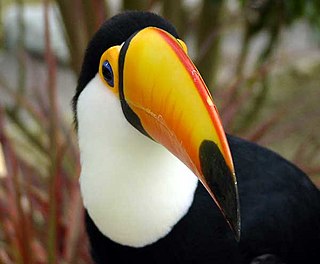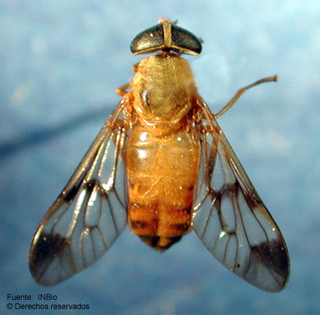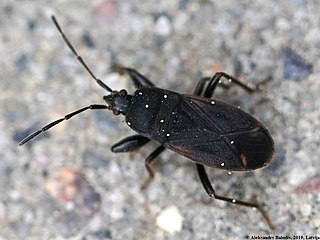Related Research Articles

The Amazon rainforest, also called Amazon jungle or Amazonia, is a moist broadleaf tropical rainforest in the Amazon biome that covers most of the Amazon basin of South America. This basin encompasses 7,000,000 km2 (2,700,000 sq mi), of which 5,500,000 km2 (2,100,000 sq mi) are covered by the rainforest. This region includes territory belonging to nine nations and 3,344 formally acknowledged indigenous territories.

Huntsman spiders, members of the family Sparassidae, are known by this name because of their speed and mode of hunting. They are also called giant crab spiders because of their size and appearance. Larger species sometimes are referred to as wood spiders, because of their preference for woody places. In southern Africa the genus Palystes are known as rain spiders or lizard-eating spiders. Commonly, they are confused with baboon spiders from the Mygalomorphae infraorder, which are not closely related.

The North Region of Brazil is the largest region of Brazil, corresponding to 45.27% of the national territory. It is the second-least-inhabited of the country, and contributes with a minor percentage in the national GDP and population. The area of the region is a little larger than India and a little smaller than the whole European Union. It comprises the states of Acre, Amapá, Amazonas, Pará, Rondônia, Roraima, and Tocantins.

The Cerrado is a vast ecoregion of tropical savanna in eastern Brazil, being present in the states of Goiás, Mato Grosso do Sul, Mato Grosso, Tocantins, Maranhão, Piauí, Bahia, Minas Gerais, São Paulo, Paraná and the Federal District. The core areas of the Cerrado biome are the Brazilian highlands – the Planalto. The main habitat types of the Cerrado consist of forest savanna, wooded savanna, park savanna and gramineous-woody savanna. The Cerrado also includes savanna wetlands and gallery forests.

The wildlife of Brazil comprises all naturally occurring animals, plants, and fungi in the South American country. Home to 60% of the Amazon Rainforest, which accounts for approximately one-tenth of all species in the world, Brazil is considered to have the greatest biodiversity of any country on the planet. It has the most known species of plants (60,000), freshwater fish (3,000), amphibians (1,188), snakes (430), insects (90,000) and mammals (775) It also ranks third on the list of countries with the most bird species (1,971) and the third with the most reptile species (848). The number of fungal species is unknown. Approximately two-thirds of all species worldwide are found in tropical areas, often coinciding with developing countries such as Brazil. Brazil is second only to Indonesia as the country with the most endemic species.

Tarantulas comprise a group of large and often hairy spiders of the family Theraphosidae. As of December 2023, 1,100 species have been identified, with 166 genera. The term "tarantula" is usually used to describe members of the family Theraphosidae, although many other members of the same infraorder (Mygalomorphae) are commonly referred to as "tarantulas" or "false tarantulas". Some of the more common species have become popular in the exotic pet trade. Many New World species kept as pets have setae known as urticating hairs that can cause irritation to the skin, and in extreme cases, cause damage to the eyes.

An endangered species is a species that is very likely to become extinct in the near future, either worldwide or in a particular political jurisdiction. Endangered species may be at risk due to factors such as habitat loss, poaching, and invasive species. The International Union for Conservation of Nature (IUCN) Red List lists the global conservation status of many species, and various other agencies assess the status of species within particular areas. Many nations have laws that protect conservation-reliant species which, for example, forbid hunting, restrict land development, or create protected areas. Some endangered species are the target of extensive conservation efforts such as captive breeding and habitat restoration.
The Junqueira cow is a cattle breed from Brazil that is the result of crosses between Caracu and other Brazilian varieties. It is of the subspecies Bos taurus ibericus and has submetacentric Y chromosomes, suggesting it is taurine in origin. The breed has been raised since the 18th century, in São Paulo but only about 100 remained in 2005. However, it has been cloned in the laboratory by the Brazilian Agricultural Research Corporation. Early on, its long horns were used to manufacture berrantes. Today, the Junqueira cow is an endangered species, with fewer than 100 left in Brazil.

Neoclytus is a genus of beetles in the family Cerambycidae. They measure 4-20 mm. There are 93 species in the New World.

Agaricocrinus americanus, also known as the mushroom crinoid or American crinoid, is a species of extinct crinoid. It's fossils can be found in the U.S. states of Indiana, Tennessee and Kentucky. They date back to the Lower Mississippian, about 345 million years ago.

The genus Helopeltis, also sometimes known as mosquito bugs, is a group of heteropterans in the family Miridae and tribe Dicyphini. They include pests of various crops, including cacao, cashew, cotton and tea. Now in a different subgenus, or placed in its own genus. A number of Afropeltis species are pests in Africa.
Neoclytus podagricus is a species of beetle in the family Cerambycidae. It was described by White in 1855.

Novius is a genus of ladybird beetles belonging to the family Coccinellidae, and the sole member of the tribe Noviini. The genus as presently defined contains over 70 species, most of which were formerly placed in the genera Rodolia and Anovia, but after decades of debate, both of these genera are now considered to be junior synonyms of Novius.

Diachlorus is a genus of biting horseflies of the family Tabanidae. D. ferrugatus ranges from the southeastern United States to Costa Rica. There are 27 species with a neotropical distribution, with the greatest diversity in Brazil, while 3 are found in Central America.

Crossocerus is a genus of square-headed wasps in the family Crabronidae. There are at least 250 described species in Crossocerus.

Neuroleon is a large and complex genus of antlions in the subfamily Myrmeleontinae. There are more than 150 described species from Europe, Asia and Africa, and there are many undescribed taxa. Where the biology of the larvae is known, they live freely in sand or in sheltered rock crevices.
Cardiacephala is a genus of flies in the family Micropezidae.

Eremocoris is a genus of dirt-colored seed bugs in the family Rhyparochromidae. There are at least 45 described species in the genus Eremocoris.

Stigmus is a genus of aphid wasps in the family Crabronidae. There are more than 20 described species in Stigmus.

Crossocerus podagricus is a Palearctic species of solitary wasp.
References
- ↑ Rondani, C. (1848). "Esame di varie specie di'insetti ditteri brasiliani" [Examination of various species of Brazilian diptera insects]. Studi entomologici (in Italian). 1 (2). Turino: 63–112.